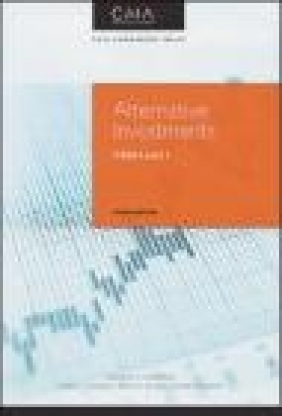Alternative Investments: CAIA Level 1
CAIA Association, Hossein Kazemi, Keith Black
Alternative Investments: CAIA Level 1
CAIA Association, Hossein Kazemi, Keith Black
- Producent: John Wiley
- Rok produkcji: 2015
- ISBN: 9781119003366
- Ilość stron: 960
- Oprawa: Twarda
Niedostępna
Opis: Alternative Investments: CAIA Level 1 - CAIA Association, Hossein Kazemi, Keith Black
The official CAIA Level 1 curriculum book, updated and expanded to reflect the March 2016 exam Alternative Investments: CAIA Level I, 3rd Edition is the curriculum book for the Chartered Alternative Investment Analyst (CAIA) Level I professional examination. Covering the fundamentals of the alternative investment space, this book helps you build a foundation in alternative investment markets. You'll look closely at the different types of hedge fund strategies and the range of statistics used to define investment performance as you gain a deep familiarity with alternative investment terms and develop the computational ability to solve investment problems. From strategy characteristics to portfolio management strategies, this book contains the core material you will need to succeed on the CAIA Level I exam. This updated third edition tracks to the latest version of the exam, and is accompanied by the following ancillaries: a workbook, study guide, learning objectives, and an ethics handbook. Most investment analyst education programs focus primarily on the traditional asset classes, pushing alternative investments to the sidelines. The CAIA designation was developed in response to the tremendous growth of alternative investing, and is the industry's premier educational standard. This book is your official study companion, bringing you fully up to speed on everything you need to know (with the exception of the ethics material covered in a separate handbook). * Understand the complexities of each alternative asset class * Learn the quantitative techniques professionals use every day * Dig into the unique aspects of alternative investments * Master the core material covered by the CAIA Level I exam More than 300 financial institutions and hedge funds have committed key executives to the CAIA exam, and this rapidly growing trend speaks to the designation's rising status as a must-have credential for anyone in the alternative investment sphere. Increase your chances of success by getting your information straight from the source in CAIA Level I.Preface xiii Acknowledgments xvii About the Authors xix PART 1 Introduction to Alternative Investments CHAPTER 1 What Is an Alternative Investment? 3 1.1 Alternative Investments by Exclusion 3 1.2 Alternative Investments by Inclusion 4 1.3 Structures among Alternative Investments 8 1.4 Investments Are Distinguished by Return Characteristics 12 1.5 Investments Are Distinguished by Methods of Analysis 15 1.6 Investments Are Distinguished by Other Factors 18 1.7 Goals of Alternative Investing 18 1.8 Overview of This Book 20 Review Questions 21 CHAPTER 2 The Environment of Alternative Investments 23 2.1 The Participants 23 2.2 Financial Markets 30 2.3 Regulatory Environment 32 2.4 Liquid Alternative Investments 37 2.5 Taxation 40 Review Questions 43 CHAPTER 3 Quantitative Foundations 45 3.1 Return and Rate Mathematics 45 3.2 Returns Based on Notional Principal 47 3.3 Internal Rate of Return 50 3.4 Problems with Internal Rate of Return 54 3.5 Distribution of Cash Waterfall 60 Review Questions 69 CHAPTER 4 Statistical Foundations 71 4.1 Return Distributions 71 4.2 Moments of the Distribution: Mean, Variance, Skewness, and Kurtosis 74 4.3 Covariance, Correlation, Beta, and Autocorrelation 79 4.4 Interpreting Standard Deviation and Variance 88 4.5 Testing for Normality 95 4.6 Time-Series Return Volatility Models 98 Review Questions 100 CHAPTER 5 Measures of Risk and Performance 101 5.1 Measures of Risk 101 5.2 Estimating Value at Risk (VaR) 105 5.3 Ratio-Based Performance Measures 111 5.4 Risk-Adjusted Return Measures 117 Review Questions 120 CHAPTER 6 Foundations of Financial Economics 121 6.1 Informational Market Efficiency 121 6.2 Single-Factor and Ex Ante Asset Pricing 124 6.3 Multifactor and Empirical Models 129 6.4 Arbitrage-Free Models 135 6.5 The Term Structure of Forward Contracts 142 6.6 Option Exposures 147 6.7 Option Pricing Models 153 6.8 Option Sensitivities 155 Review Questions 157 CHAPTER 7 Benchmarking and Performance Attribution 159 7.1 Benchmarking 159 7.2 Types of Models 162 7.3 Performance Attribution 165 7.4 Distinctions Regarding Alternative Asset Benchmarking 169 Review Questions 172 CHAPTER 8 Alpha, Beta, and Hypothesis Testing 175 8.1 Overview of Beta and Alpha 175 8.2 Ex Ante versus Ex Post Alpha 177 8.3 Inferring Ex Ante Alpha from Ex Post Alpha 180 8.4 Return Attribution, Alpha, and Beta 182 8.5 Ex Ante Alpha Estimation and Return Persistence 185 8.6 Return Drivers 186 8.7 Using Statistical Methods to Locate Alpha 188 8.8 Sampling and Testing Problems 193 8.9 Statistical Issues in Analyzing Alpha and Beta 197 Review Questions 201 CHAPTER 9 Regression, Multivariate, and Nonlinear Methods 203 9.1 Single-Factor Models and Regression 203 9.2 Multifactor Models and Regression 208 9.3 Three Dynamic Risk Exposure Models 210 9.4 Two Approaches to Modeling Changing Correlation 212 9.5 Four Multifactor Approaches to Understanding Hedge Fund Returns 215 9.6 Evidence on Fund Performance Persistence 219 Review Questions 221 PART 2 Real Assets CHAPTER 10 Natural Resources and Land 225 10.1 Natural Resources Other Than Land 225 10.2 Land 230 10.3 Timber and Timberland 236 10.4 Farmland 238 10.5 Valuation and Volatility of Real Assets 242 10.6 Historical Risks and Returns 246 Review Questions 249 CHAPTER 11 Commodity Forward Pricing 251 11.1 Forward Contracts versus Futures Contracts 251 11.2 Rolling Contracts 259 11.3 The Term Structure of Forward Prices on Commodities 260 11.4 Backwardation and Contango 266 11.5 Returns on Forward Contracts 270 Review Questions 275 CHAPTER 12 Commodities: Applications and Evidence 277 12.1 Commodity Investing for Diversification 277 12.2 Commodity Investing for Return Enhancement 280 12.3 Investing in Commodities without Futures 282 12.4 Commodity Exposure through Futures Contracts 287 12.5 Commodity Futures Indices 294 12.6 Commodity Risks and Returns 296 12.7 Historical Risks and Returns 298 Review Questions 301 CHAPTER 13 Operationally Intensive Real Assets 303 13.1 Commodity Producers 303 13.2 Liquid Alternative Real Assets 306 13.3 Infrastructure 309 13.4 Intellectual Property 315 Review Questions 319 CHAPTER 14 Liquid and Fixed-Income Real Estate 321 14.1 Real Estate as an Investment 321 14.2 Residential Mortgages 323 14.3 Commercial Mortgages 333 14.4 Mortgage-Backed Securities Market 335 14.5 Liquid Alternatives: Real Estate Investment Trusts 341 14.6 Historical Risks and Returns of Mortgage REITs 342 Review Questions 345 CHAPTER 15 Real Estate Equity Investments 347 15.1 Real Estate Development 347 15.2 Valuation and Risks of Real Estate Equity 351 15.3 Alternative Real Estate Investment Vehicles 358 15.4 Real Estate and Depreciation 364 15.5 Real Estate Equity Risks and Returns 370 15.6 Historical Risks and Returns of Equity REITs 374 Review Questions 377 PART 3 Hedge Funds CHAPTER 16 Structure of the Hedge Fund Industry 381 16.1 Distinguishing Hedge Funds 381 16.2 Hedge Fund Fees 387 16.3 Hedge Fund Classification 400 16.4 Hedge Fund Returns and Asset Allocation 402 16.5 Evaluating a Hedge Fund Investment Program 407 16.6 Do Hedge Funds Adversely Affect the Financial Markets? 410 16.7 Hedge Fund Indices 412 16.8 Conclusion 420 Review Questions 420 CHAPTER 17 Macro and Managed Futures Funds 423 17.1 Major Distinctions between Strategies 423 17.2 Global Macro 425 17.3 Returns of Macro Investing 429 17.4 Managed Futures 431 17.5 Systematic Trading 435 17.6 Systematic Trading Strategies 438 17.7 Evidence on Managed Futures Returns 448 17.8 Analysis of Historical Returns Conclusion 455 Review Questions 457 CHAPTER 18 Event-Driven Hedge Funds 459 18.1 The Sources of Most Event Strategy Returns 459 18.2 Activist Investing 462 18.3 Merger Arbitrage 473 18.4 Distressed Securities Funds 482 18.5 Event-Driven Multistrategy Funds 495 Review Questions 498 CHAPTER 19 Relative Value Hedge Funds 499 19.1 Overview of Relative Value Strategies 499 19.2 Convertible Bond Arbitrage 500 19.3 Volatility Arbitrage 518 19.4 Fixed-Income Arbitrage 532 19.5 Relative Value Multistrategy Funds 543 Review Questions 546 CHAPTER 20 Equity Hedge Funds 547 20.1 Sources of Return 548 20.2 Market Anomalies 552 20.3 The Fundamental Law of Active Management 558 20.4 Implementing Anomaly Strategies 561 20.5 The Three Equity Strategies 565 20.6 Equity Hedge Fund Risks 577 Review Questions 580 CHAPTER 21 Funds of Hedge Funds 583 21.1 Overview of Funds of Hedge Funds 583 21.2 Investing in Multistrategy Funds 592 21.3 Investing in Funds of Hedge Funds 594 21.4 Investing in Portfolios of Single Hedge Funds 598 21.5 Multialternatives and Other Hedge Fund Liquid Alternatives 598 21.6 Historical Returns of Funds of Funds 604 Review Questions 608 PART 4 Private Equity CHAPTER 22 Introduction to Private Equity 613 22.1 Private Equity Terminology and Background 613 22.2 Private Equity as Equity Securities 616 22.3 Private Equity as Debt Securities 620 22.4 Private Equity Liquid Alternatives 625 22.5 Trends and Innovations in Private Equity 630 Review Questions 635 CHAPTER 23 Equity Types of Private Equity 637 23.1 Contrasts between Venture Capital and Buyouts 637 23.2 The Underlying Businesses of Venture Capital 638 23.3 Venture Capital Funds 639 23.4 The Dynamics of Venture Capital 642 23.5 Venture Capital Risks and Returns 648 23.6 Types of Buyouts 652 23.7 Leveraged Buyout Details 655 Review Questions 665 CHAPTER 24 Debt Types of Private Equity 667 24.1 Mezzanine Debt 667 24.2 Distressed Debt 675 Review Questions 681 PART 5 Structured Products CHAPTER 25 Introduction to Structuring 685 25.1 Overview of Financial Structuring 685 25.2 Major Types of Structuring 686 25.3 The Primary Economic Role of Structuring 687 25.4 Collateralized Mortgage Obligations 689 25.5 Structural Model Approach to Credit Risk 697 25.6 Introduction to Collateralized Debt Obligations 703 Review Questions 707 CHAPTER 26 Credit Risk and Credit Derivatives 709 26.1 An Overview of Credit Risk 709 26.2 Reduced-Form Modeling of Credit Risk 710 26.3 Credit Derivatives Markets 717 26.4 Credit Default Swaps 720 26.5 Other Credit Derivatives 728 26.6 CDS Index Products 731 26.7 Five Key Risks of Credit Derivatives 732 Review Questions 734 CHAPTER 27 CDO Structuring of Credit Risk 737 27.1 Overview of CDO Variations 737 27.2 Balance Sheet CDOs and Arbitrage CDOs 740 27.3 Mechanics of and Motivations for an Arbitrage CDO 742 27.4 Cash-Funded CDOs versus Synthetic CDOs 744 27.5 Cash Flow CDOs versus Market Value CDOs 748 27.6 Credit Enhancements 749 27.7 Developments in CDOs 751 27.8 Risks of CDOs 752 Review Questions 757 CHAPTER 28 Equity-Linked Structured Products 759 28.1 Structured Products and Six Types of Wrappers 759 28.2 Four Potential Tax Effects of Wrappers 760 28.3 Structured Products with Exotic Option Features 763 28.4 Global Structured Product Cases 770 28.5 Structured Product Pricing 775 28.6 Motivations of Structured Products 778 Review Questions 780 PART 6 Risk Management and Portfolio Management CHAPTER 29 Cases in Tail Events 783 29.1 Problems Driven by Market Losses 783 29.2 Trading Technology and Financial Crises 790 29.3 Failures Driven by Fraud 792 29.4 Four Major Lessons from Cases in Tail Events 799 Review Questions 799 CHAPTER 30 Investment Process, Operations, and Risk 801 30.1 Investment Strategy and Process 801 30.2 Investment Process and Market Risk 803 30.3 The Three Internal Fund Activities 805 30.4 Operational Risk 806 30.5 Controlling Operational Risk 808 30.6 Controlling Risk of Portfolios with Options 812 Review Questions 814 CHAPTER 31 Due Diligence of Fund Managers 815 31.1 Due Diligence Evidence and Organization 815 31.2 Screening with Three Fundamental Questions 816 31.3 Structural Review 820 31.4 Strategic Review 824 31.5 Administrative Review 827 31.6 Performance Review 829 31.7 Portfolio Risk Review 835 31.8 Legal Review 838 31.9 Reference Review 841 31.10 Evidence on Operational Risk 842 Review Questions 843 CHAPTER 32 Portfolio Management, Alpha, and Beta 845 32.1 Alpha and Smart Beta 845 32.2 The Estimation of Alpha and Beta 846 32.3 The Separation of Alpha and Beta 847 32.4 Portable Alpha 848 32.5 Alpha, Beta, and Portfolio Allocation 853 Review Questions 858 APPENDIX Data Sources 859 Computations and Explanations 867 Index 875
Szczegóły: Alternative Investments: CAIA Level 1 - CAIA Association, Hossein Kazemi, Keith Black
Tytuł: Alternative Investments: CAIA Level 1
Autor: CAIA Association, Hossein Kazemi, Keith Black
Producent: John Wiley
ISBN: 9781119003366
Rok produkcji: 2015
Ilość stron: 960
Oprawa: Twarda
Waga: 0.67 kg






























